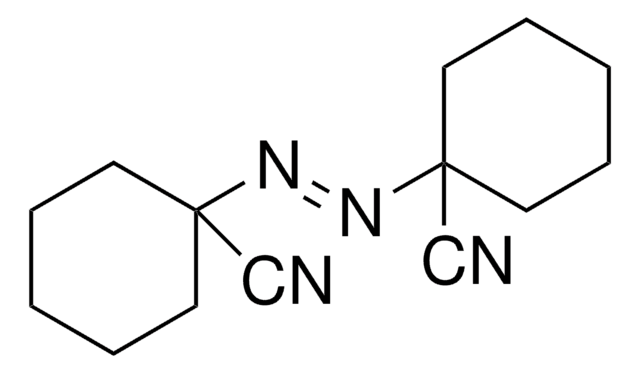Kluczowe dokumenty
11596
2,2′-Azobis(2-methylbutyronitrile)
≥98.0%
Synonim(y):
2,2′-(1,2-Diazenediyl)bis[2-methylbutanenitrile], 2,2′-(Diazene-1,2-diyl)bis(2-methylbutanenitrile), 2,2′-Azobis(2-cyanobutane), 2,2′-Dimethyl-2,2′-azodibutyronitrile, 2-[2-(1-Cyano-1-methylpropyl)diazen-1-yl]-2-methylbutanenitrile, Azobisisoamylonitrile, Azocatalyst M
About This Item
Polecane produkty
Poziom jakości
Próba
≥98.0%
Postać
solid
mp
49-52 °C
grupa funkcyjna
azo
nitrile
temp. przechowywania
2-8°C
ciąg SMILES
CCC(C)(\N=N\C(C)(CC)C#N)C#N
InChI
1S/C10H16N4/c1-5-9(3,7-11)13-14-10(4,6-2)8-12/h5-6H2,1-4H3/b14-13+
Klucz InChI
AVTLBBWTUPQRAY-BUHFOSPRSA-N
Szukasz podobnych produktów? Odwiedź Przewodnik dotyczący porównywania produktów
Opis ogólny
Zastosowanie
Przechowywanie i stabilność
Hasło ostrzegawcze
Danger
Zwroty wskazujące rodzaj zagrożenia
Zwroty wskazujące środki ostrożności
Klasyfikacja zagrożeń
Acute Tox. 4 Oral - Self-react. D
Kod klasy składowania
4.1A - Other explosive hazardous materials
Klasa zagrożenia wodnego (WGK)
WGK 1
Temperatura zapłonu (°F)
Not applicable
Temperatura zapłonu (°C)
Not applicable
Środki ochrony indywidualnej
Eyeshields, Gloves, type P3 (EN 143) respirator cartridges
Wybierz jedną z najnowszych wersji:
Masz już ten produkt?
Dokumenty związane z niedawno zakupionymi produktami zostały zamieszczone w Bibliotece dokumentów.
Klienci oglądali również te produkty
Nasz zespół naukowców ma doświadczenie we wszystkich obszarach badań, w tym w naukach przyrodniczych, materiałoznawstwie, syntezie chemicznej, chromatografii, analityce i wielu innych dziedzinach.
Skontaktuj się z zespołem ds. pomocy technicznej









